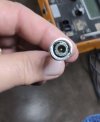SoCal 182 Driver
Cleared for Takeoff
- Joined
- Sep 11, 2019
- Messages
- 1,017
- Display Name
Display name:
SoCal 182 Driver
I've been having some intermittent transponder problems -- ATC saying they can't see my Mode C, etc. I recently took the plane into the avionics shop for some troubleshooting, and we discovered that the connector on the cable to the antenna looked like this:

On the inside of the fuselage of my 1967 C182K, all around the area where the antenna is mounted, was a black, rubber-ish material. (Unfortunately, I didn't get a picture.) The avionics tech joked that it looked like roofing tar, but another tech said it was used by Cessna back in the day to prevent oil-canning. Whatever it is, apparently it somehow off-gassed (or through some other mechanism), and fouled the connector on the cable to the antenna. I can't think of any other reason the connector would look like it does in the picture. (FYI, the connector is probably about 4 years old. New cabling was installed when I upgraded the transponder for the ADS-B mandate.)
I'd like to clean the area around the antenna and remove some of the black material from the fuselage. Is there a "tried and true" method of removing that stuff?
Thanks!

On the inside of the fuselage of my 1967 C182K, all around the area where the antenna is mounted, was a black, rubber-ish material. (Unfortunately, I didn't get a picture.) The avionics tech joked that it looked like roofing tar, but another tech said it was used by Cessna back in the day to prevent oil-canning. Whatever it is, apparently it somehow off-gassed (or through some other mechanism), and fouled the connector on the cable to the antenna. I can't think of any other reason the connector would look like it does in the picture. (FYI, the connector is probably about 4 years old. New cabling was installed when I upgraded the transponder for the ADS-B mandate.)
I'd like to clean the area around the antenna and remove some of the black material from the fuselage. Is there a "tried and true" method of removing that stuff?
Thanks!
